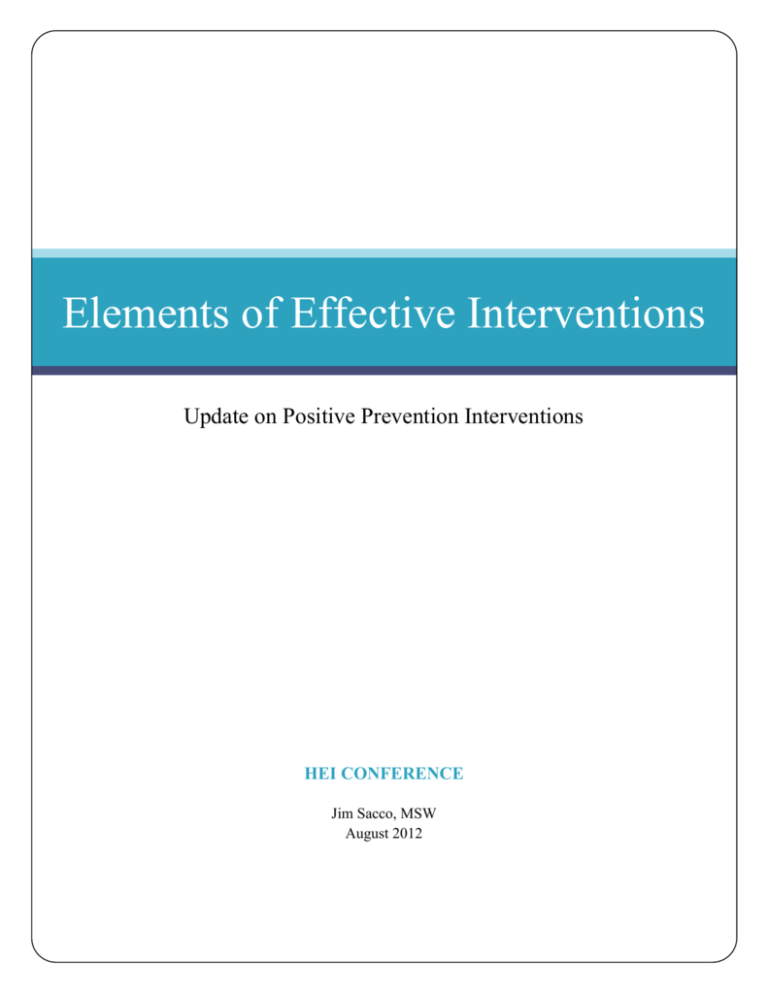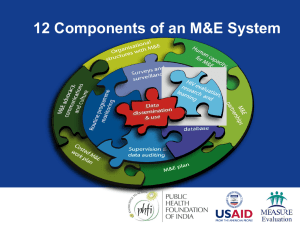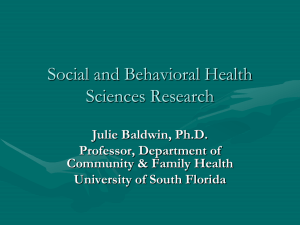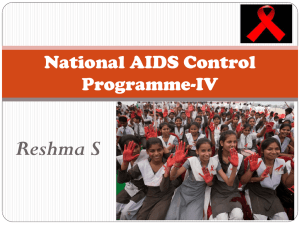Elements of Effective Interventions
advertisement

Elements of Effective Interventions Update on Positive Prevention Interventions HEI CONFERENCE Jim Sacco, MSW August 2012 Elements of Effective Interventions Update on Positive Prevention Interventions Overview Positive Prevention/Adherence Interventions can be divided into four primary categories based on the following types of strategies they employ: 1) 2) 3) 4) HIV Adherence Strategies Public Health Strategies Behavioral Strategies Structural Strategies Suggestions from Charles Collins [CDC] on the role of outreach workers: Elements of Effective Interventions 1 Recruiting clients into interventions is a critical function of outreach workers. Outreach workers conducting condom distribution and rapid testing could recruit clients into ARTAS, CRCS, CLEAR, and Health Relationships. Rapid Testing is a critical intervention; outreach workers are in a pivotal role to identify most at risk populations and conduct HIV testing. Linking newly identifies staff to case management, medical services, and facilitating access to PwP interventions should be the primary focus. Outreach workers/positive peers are collaborating extensively with clinics to act as patient navigators, to deliver adherence interventions, to assist with referrals, and to identify individuals in need of additional secondary prevention support. I. HIV Adherence Strategies Elements of Effective Interventions Strategy Name 2 Target Population Description Duration Project Heart (Helping Enhance Adherence to Antiretroviral Therapy) ART- naïve Social support/problem-solving, individual/dyadic intervention delivered before and in the first 2 months after initiation of ART. A patient-identified support partner is required to attend at least 2 of the first 4 sessions Five 1 1/2 to 2hr. sessions and 5 phone calls over 6 months Partnership for Health ARTexperienced Brief, clinic-based individual-level, 3 to 5 minute provider-administered intervention session at each emphasizing the importance of the clinic visit patient-provider relationship to promote patient’s healthful behavior. Adherence messages are delivered to the patient during routine medical visits and the use of posters and brochures convey the partnership theme and adherence messages Peer Support ARTexperiencedor ART naïve Individual-and group-level intervention, where HIV-positive individuals, currently adherent to ART serve as peers, who provide medication-related social support through group and weekly telephone calls to patients initiating or changing their ART regimen. Six twicemonthly 1-hour group meetings and weekly phone calls over 3 months Text Messaging ARTexperiencedor ART naïve Individual-level intervention, where patients receive text message reminders customized to their daily medication regimen. Daily customized text messages over 3 months SMART Couples Sharing Medical Adherence Responsibilities Together HIVserodiscordant couples, with poor medication adherence in the HIVpositive A couple-level intervention administered to sero-discordant couples that addresses adherence to ART and safe sex behaviors within the couple dyad, fostering active support of both individuals. Four 45-60 minute sessions over 5 weeks Elements of Effective Interventions partner 3 II. Public Health Strategies Anti-Retroviral Treatment and Access to Services (ARTAS) - ARTAS is an individual-level, multi-session, time-limited intervention with the goal of linking recently diagnosed persons with HIV to medical care soon after receiving their positive test result. ARTAS is based on the Strengths-based Case Management (SBCM) model, which is rooted in Social Cognitive Theory (particularly self-efficacy) and Humanistic Psychology. SBCM is a model that encourages the client to identify and use personal strengths; create goals for himself/herself; and establish an effective, working relationship with the Linkage Coordinator (LC). Counseling and Testing (CTR) - see CDC Procedural Guidance for CBOs [August 2009] If more than 20% of individuals living with HIV are unaware of their status, this continues to present huge challenges to linking these people to care and encouraging HIV prevention activities. Rapid testing of highest risk individuals continues to be a key strategy to identify those unaware or their status. Elements of Effective Interventions Comprehensive Risk Counseling Services (CRCS) - CRCS, formerly Prevention Case Management (PCM), is a client-centered HIV prevention activity with the goal of adoption and maintenance of HIV risk-reduction behaviors. Originally, CRCS was conceived as a combination of HIV risk-reduction counseling and conventional case management for persons at high risk of transmitting or acquiring HIV. As such, CRCS typically provided intensive, ongoing, individualized prevention counseling, support, and service brokerage. However, information from CRCS demonstration projects indicates that a more successful model for CRCS for HIV-infected persons clearly defines the CRCS prevention counselor’s primary role as working closely with existing case management systems to provide other services to clients. Where such case management systems are not available, the prevention counselor is still encouraged to support the client by providing traditional case management services such as linkage to needed services. 4 III. Behavioral Interventions CLEAR: Choosing Life: Empowerment! Action! Result - CLEAR is an evidence-based, health promotion intervention for males and females ages 16 and older living with HIV/AIDS or at high-risk for HIV. CLEAR is a client-centered program delivered one-on-one using cognitive behavioral techniques to change behavior. The intervention provides clients with the skills necessary to be able to make healthy choices for their lives. The Centers for Disease Control and Prevention's (CDC's) guidelines on Comprehensive Risk Counseling and Services (CRCS), formerly known as Prevention Case Management (PCM), identify CLEAR as a structured intervention that may be integrated into CRCS programs. Healthy Relationships - Healthy Relationships is a five-session, small-group intervention for men and women living with HIV/AIDS. It is based on Social Cognitive Theory and focuses on developing skills and building self-efficacy and positive expectations about new behaviors through modeling behaviors and practicing new skills. Holistic Harm Reduction (HHRP) - HHRP is a 12-session, manual-guided, group-level program for HIV-positive and HIV negative injection drug users. The primary goals of HHRP are health promotion and improved quality of life. More specific goals are abstinence from illicit drug use or from sexual risk behaviors; reduced drug use; reduced risk for HIV transmission; and improved medical, psychological, and social functioning. HHRP is based on the InformationMotivation-Behavioral Skills (IMB) model of HIV prevention behavioral change. This intervention is offered delivered by methadone counselors in methadone clinics. Elements of Effective Interventions Partnership for Health (PfH) – PfH is a brief, safer sex intervention in clinics. It uses message framing, repetition, and reinforcement during patient visits to increase HIV positive patients' knowledge, skills, and motivations to practice safer sex. The program is designed to improve patient-provider communication about safer sex, disclosure of HIV serostatus, and HIV prevention. All staff in the clinic are trained and support the physician-delivered interventions. 5 IV. Structural Interventions Condom Distribution Those interested in designing and implementing a CD program should consider including these elements: Provide condoms free of charge. Conduct wide-scale distribution. Implement a social marketing campaign to promote condom use (by increasing awareness of condom benefits and normalizing condom use within communities). Conduct both promotion and distribution activities at the individual, organizational, and environmental levels. Target: 1) individuals at high risk, 2) venues frequented by high-risk individuals, 3) communities at greatest risk for HIV infection, especially those marginalized by social, economic, or other structural conditions, or 4) the general population within jurisdictions with high HIV incidence. Supplement the CD program with more intense risk reduction interventions or other prevention or health services for individuals at highest risk. Integrate CD program activities within other community-level intervention approaches to promote condom use and other risk reduction behaviors. Establish organizational support for condom distribution and promotion activities in traditional and non-traditional venues. Conduct community-wide mobilization efforts to support and encourage condom use. Elements of Effective Interventions Recruitment and Retention 6 Outreach workers are in a central role to recruit clients into care/prevention services. Meeting most at risk individuals and forming relationships, explaining availability of services, de-stigmatizing HIV testing, delivering condoms, and emphasizing value of screening/treatment of HIV are critical public health activities. In clinic settings, outreach workers are increasing used to orient new consumers, deliver adherence interventions, identify needs for PwP, and deliver select PwP interventions.




